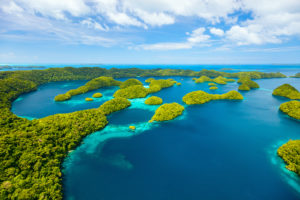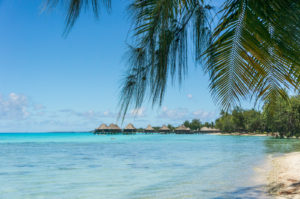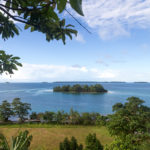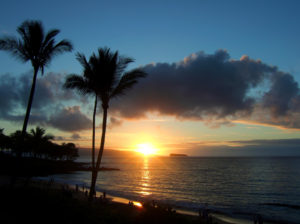The Pacific Ocean reaches staggering depths of over 30,000 feet (10,000-plus m) and is home to between 20,000 and 30,000 islands. And boasting Melanesia, Micronesia and Polynesia, the South Pacific is a diver's dream destination. The islands offer something for every diver plus glorious weather topside year-round. Landscapes are diverse and marine life ranges from plentiful macro life to the ocean's giants. There are numerous wreck-diving opportunities, caves, islands and atolls to explore, and of course the friendly welcome of the Pacific Islanders. The constantly warm water means a shorty, 3mm or 5 mm wetsuit is plenty to enjoy this paradise. Here are our top five South Pacific dive destinations.

Micronesia
Where is it: Western Pacific
What makes it special: The region of Micronesia encompasses thousands of small islands. It includes several sovereign countries, including the Federated States of Micronesia, Palau, Kiribati, the Marshall Islands and Nauru, as well as the U.S territories of Guam, the Northern Mariana Islands and Wake Island. The most well-known dive destinations are Chuuk Lagoon and Palau. Chuuk Lagoon is world-famous among wreck divers for its abundance of World War II wrecks, resulting from the American attack on the Japanese fleet, known as Operation Hailstorm. Ranging in depths from recreational to technical, 44 ships and 250 plane wrecks await exploration in the largely current-free lagoon.
Palau is also home to world-class wreck diving, plus caves, drop-offs, drift dives and abundant marine life. German Channel is a great dive for spotting manta rays and Ulong Channel offers the opportunity to fly with the current past the world's largest lettuce coral.
Why they're good spots for a liveaboard: Both Palau and Chuuk are remote destinations for most divers and, in the case of Palau, widely scattered dive sites. Exploring via liveaboard gives you a chance to see the most while you're there. There are a variety of good options, including the S/Y Palau Siren liveaboard and the Truk Master.
Details: There are dives suitable for all experience levels in Micronesia, though some dive sites in Chuuk will require wreck and/or technical certification because of depth. The water is between 79 and 86 F (26 to 30 F) year-round. Liveaboards depart from Koror in Palau and Weno on Chuuk; both have international airports.
When to go: The best time to visit Chuuk Lagoon is all year, given its sheltered nature. The dry season falls between December and April. Palau's dry season and calm seas coincide with the high season of December to March. The low season months of May, June and September have more variable weather than the shoulder season months but offer quieter dive sites and lower prices.

French Polynesia
Where is it: South Pacific
What makes it special: French Polynesia is made up of 118 islands and was one of the last places on Earth settled by humans. Only half of the islands are inhabited, and the archipelago is rich with underwater landscapes and marine life. French Polynesia offers atoll diving, drift dives and big pelagics. Rangiroa is a dive highlight, being one of the largest atolls in the world at almost 66 square miles (170 km2). Divers can see schools of gray reef sharks, occasional tiger sharks, Napoleon wrasse and manta rays. Fakarava atoll is home to numerous gray reef sharks and plenty of manta-cleaning stations. Other Polynesian dive highlights include spawning marbled groupers and the pristine corals of Pakaka Pass at Apataki.
Why it's good for a liveaboard: It's easiest to access French Polynesia's most remote dive sites by liveaboard, which will really allow you to explore the area in depth. Fakarava atoll is so diverse that some liveaboards spend their entire safari diving its different sites. Liveaboard vessels include the French Polynesia Master.
Details: French Polynesia is best for experienced divers, as currents in the atolls can be very strong. You'll often need a reef hook. To dive in these conditions, Polynesian authorities require divers to be rescue-certified if they wish to go below 98 feet (30 m). The water temperature ranges from 75 to 83 F (24 to 28 C). Fa'a'ā Airport on Tahiti island is the only international airport; you can take domestic flights from there to reach liveaboard departure points.
When to go: Scuba diving is possible all year. January to March are humid but offer the warmest water temperatures, while July to November is drier and cooler. You can see humpback whales during the colder season and marbled grouper spawn in June and July.

Papua New Guinea
Where is it: Southwestern Pacific
What makes it special: Papua New Guinea, or PNG, is a truly diverse nation, made up of over 600 volcanic islands and atolls and with over 852 known languages. It has spectacular reef, wall, and seamount diving. You can see six of the seven sea-turtle species here and more than 2,000 species of reef fish. Muck diving offers bizarre critters tucked into coral gardens and black sand at dive sites such as Kimbe Bay, the Witu Islands and Father's Reefs. Milne Bay features a variety of World War II wrecks as well as fantastic muck diving. PNG is paradise for underwater photographers, with the bonus of few other divers and peaceful, remote dive sites.
Why it's good for a liveaboard: PNG is another remote dive destination that's a fantastic choice for a liveaboard. Friendly locals will often paddle out to trade fresh produce with visiting boats.
Details: The diving is suitable for all levels of certified divers, though PNG is best for intermediate or advanced divers to take advantage of the variety of sites. Water temperatures vary from 79 to 88 F (26 to 31 C). You can reach PNG via flights from nearby countries such as Australia. Domestic flights depart from the international airport in Port Moresby. If possible, divers should pack light, as domestic flight baggage allowance can be as little as 22 to 35 pounds (10 to 16 kg) for checked baggage.
When to go: Diving is good all year and the high season is between May and November. The climate is hot and humid year-round.

Marovo Lagoon
Where is it: Solomon Islands, South Pacific
What makes it special: With 922 islands, the Solomon Islands are a popular dive destination in the Pacific for wreck and reef diving. Sites are uncrowded and offer diverse marine life as well as World War II wrecks and dump sites. One of the most remote destinations within the Solomon Islands is Marovo Lagoon, the world's largest saltwater lagoon and also the home of a double-barrier reef. Nearby sites also feature plenty of World War II wrecks and Being once occupied by U.S forces in World War II, there are plenty of wrecks and White Beach's seabed in the Russell Islands is littered with boats, trucks and jeeps that have become flourishing artificial reefs. Marine life includes schools of barracuda, turtles, sharks, manta rays and even the occasional salt water crocodile.
Why it's good for a liveaboard: Liveaboard safaris allow you to see the very best of the Solomon Islands, reaching sites that are otherwise inaccessible. The well-known Bilikiki will get you there in style.
Details: Dive sites in the Solomon Islands are suitable for all experience levels. The water temperature varies from around 79 to 83 F (26 to 28 C). The capital of Honiara is the gateway to the Solomon Islands and is accessible via flights from Fiji or Australia.
When to go: Diving is possible year-round. The rainy season falls from November to April and cyclones rarely occur in this area.

Hawaii
Where is it: United States, North Pacific
What makes it special: While Hawaii is certainly less exotic than many of our Pacific picks, the broad range of dives should keep divers of all interests and abilities busy. The Hawaiian island chain is made up of 132 islands with plentiful dive sites and constantly changing underwater scenery thanks to the active volcanoes. The Big Island has more than 50 dive sites with lava tubes, coral gardens and numerous endemic fish. Kona is famous for its night dives with manta rays and Oahu is home to countless eagle rays, frogfish, turtles and the YO-257 and San Pedro wrecks. The Molokini Crater of Maui is a dive highlight and First and Second Cathedral in Lanai will delight with beautiful light shafts and topography. Although you cannot dive with them, visitors from November through May should book a whale-watching expedition to get a closer look at some of Maui's large, seasonally migrating population of humpback whales.
Why it's good for a liveaboard: Exploring Hawaii by liveaboard allows divers to explore the best of each island more easily and to reach the more remote island dive sites, all during one safari.
Details: Hawaii diving is suitable for all experience levels. The water temperature varies from 75 to 79 F (24 to 26 C). Hawaii is easily accessible from various international airports.
When to go: Diving is possible year-round but the best time to dive is during the winter months as mentioned, when divers may hear humpback whale songs as dive.
This article was written by divers and writers of Liveaboard.com
The post Top Five South Pacific Dive Destinations appeared first on Scuba Diver Life.
from Scuba Diver Life https://ift.tt/2LHzNm2
No comments:
Post a Comment